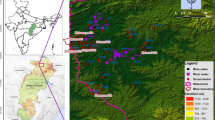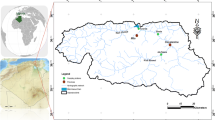Abstract
Ninety-three water samples were categorized into five classes as the tap, mineral, mineral carbonated, spring, and spring carbonated water, or, alternatively, into four or three categories — with all spring water samples together or as tap, mineral, and spring water, respectively. The samples originated from four European countries and thirty-one chemical descriptors (concentrations of contained elements) were used for their characterization. Analytical measurements were performed by mass spectrometry with inductively coupled plasma, allowing the determination of individual nuclides. Different water categories were characterized by chemometrical techniques, mainly by principal component analysis, cluster analysis, linear and quadratic discriminant analyses, correlation analysis, and ANOVA. Their role was to discover the nuclides important for distinct characterization of individual water categories as well as to assess the possibility of water samples from different countries being recognized from the increased/decreased content of some elements. The enhanced content of Cd, Cu, Zn, Bi, and Fe was characteristic for tap water samples, whilst mineral water samples were characterized by the elevated concentration of Sr, Li, B, Ni, Co, As, and Sb. The classification results were successful and close to 100 %, which was proved by the leave-one-out cross-validation procedure.
Similar content being viewed by others
References
Cvijović, Z., Radenković, G., Maksimović, V., & Dimčić, B. (2005). Application of ANOVA method to precipitation behaviour studies. Material Science Engineering, A397, 195–203. DOI: 10.1016/j.msea.2005.02.021.
Directive 98/83/EC (1998). Quality of water intended for human consumption. Official Journal No. L330, 32–40. Brussels: EEC Council.
Everitt, B. S., & Dunn, G. (2001). Applied multivariate data analysis (2nd ed.). London: Arnold.
Fiket, Ž., Roje, V., Mikac, N., & Kniewald, G. (2007). Determination of arsenic and other trace elements in bottled waters by high resolution inductively coupled plasma mass spectrometry. Croatica Chemica Acta, 80, 91–100.
Jarvis, K. E., Gray, A. L, & Houk, R. S. (1992). Inductively coupled plasma mass spectrometry. New York: Blackie.
Kannel, P. R., Lee, S., Kanel S. R., & Khan, S. P. (2007). Chemometric application in classification and assessment of monitoring locations of an urban river system. Analytica Chimica Acta, 582, 390–399. DOI: 10.1016/j.aca.2006.09.006.
Khattree, R., & Naik, N. N. (2000). Multivariate data reduction and discrimination with SAS software. Cary, N.J.: SAS Institute.
Lankmayr, E., Mocak, J., Serdt, K., Balla, B., Wenzl, T., Bandoniene, D., Gfrerer, M., & Wagner, S. (2004) Chemometrical classification of pumpkin seed oils using UV-Vis, NIR, and FTIR spectra. Journal of Biochemical and Biophysical Methods, 61, 95–106. DOI: 10.1016/j.jbbm.2004.04.007.
Mellinger, M. (1987). Multivariate data analysis: Its methods. Chemometrics and Intelligent Laboratory Systems, 2, 29–36. DOI: 10.1016/0169-7439(87)80083-7.
Penza, M., & Cassano, G. (2004). Chemometric characterization of Italian wines by thin-film multisensors array and artificial neural networks. Food Chemistry, 86, 283–296. DOI: 10.1016/j.foodchem.2003.09.027.
Sharma, S. (1996). Applied multivariate techniques. New York: J. Wiley.
Slovak Technical Standard. (1998). Kvalita vody (Water quality). Pitná voda (Drinking water). STN 757111. Bratislava: Slovak Standards Institute.
SPSS 15 (2006). Computer software. Chicago: SPSS Inc.
Šnuderl, K., Simonič, M., Mocak, J., & Brodnjak-Vončina, D. (2007). Multivariate data analysis of natural mineral waters. Acta Chimica Slovenica, 54, 33–39.
Statgraphics Plus 5.1 (2001). Computer software. Herndon: StatPoint Inc.
Author information
Authors and Affiliations
Corresponding author
Rights and permissions
About this article
Cite this article
Kraic, F., Mocák, J., Fiket, Ž. et al. ICP MS analysis and classification of potable, spring, and mineral waters. Chem. Pap. 62, 445–450 (2008). https://doi.org/10.2478/s11696-008-0063-6
Received:
Revised:
Accepted:
Published:
Issue Date:
DOI: https://doi.org/10.2478/s11696-008-0063-6




